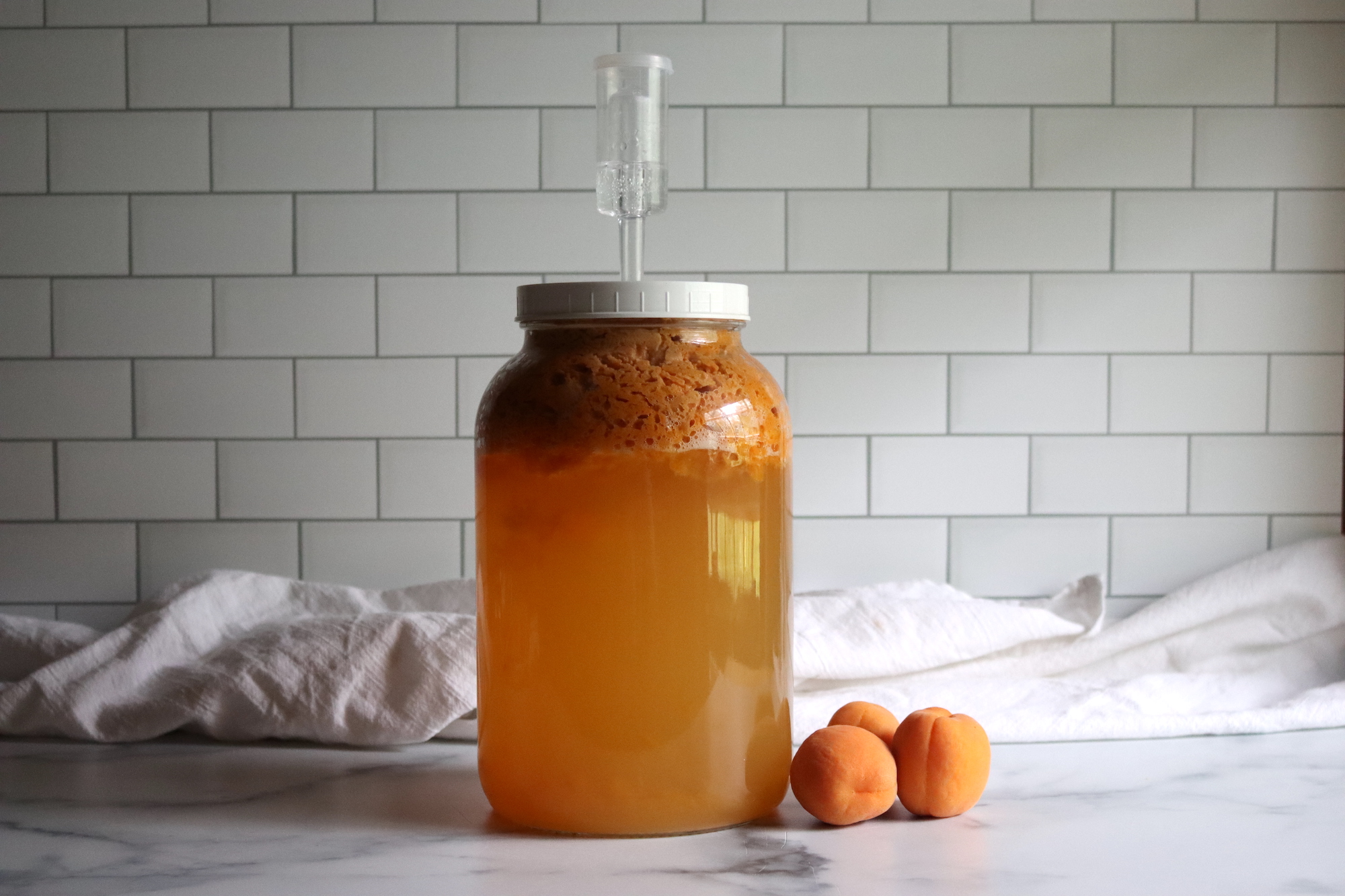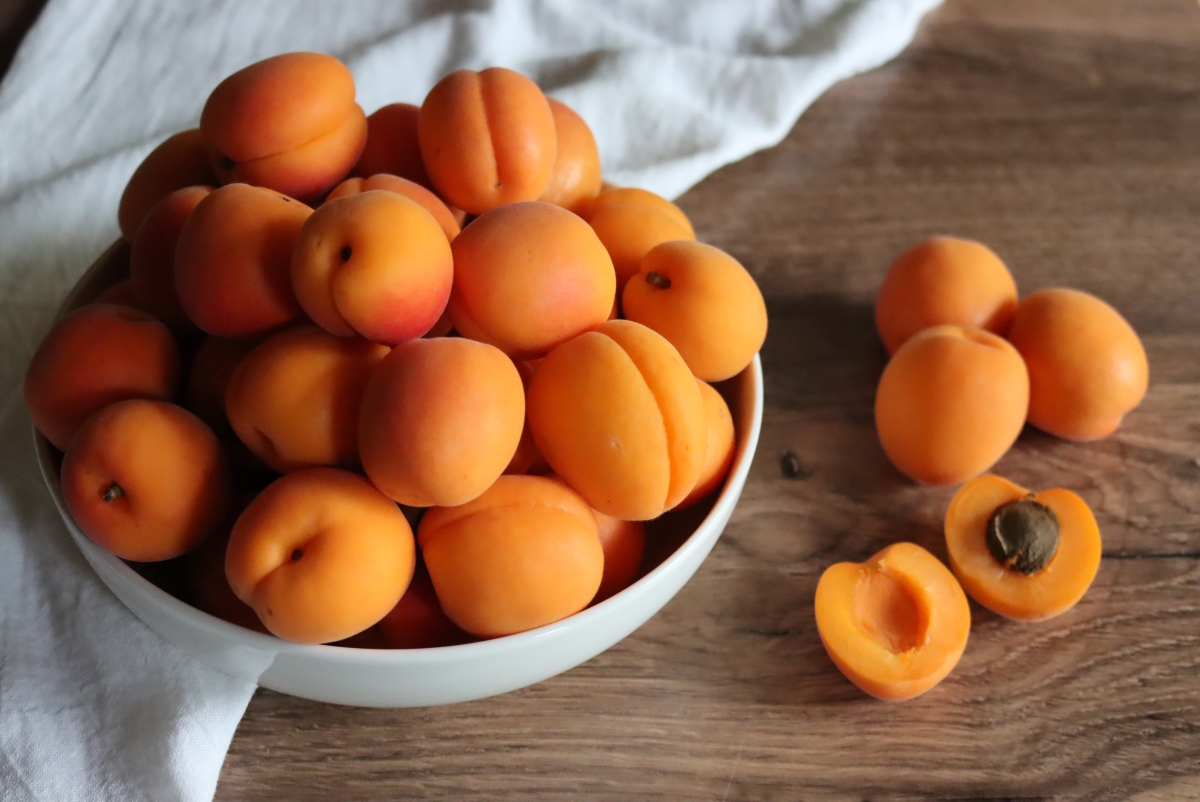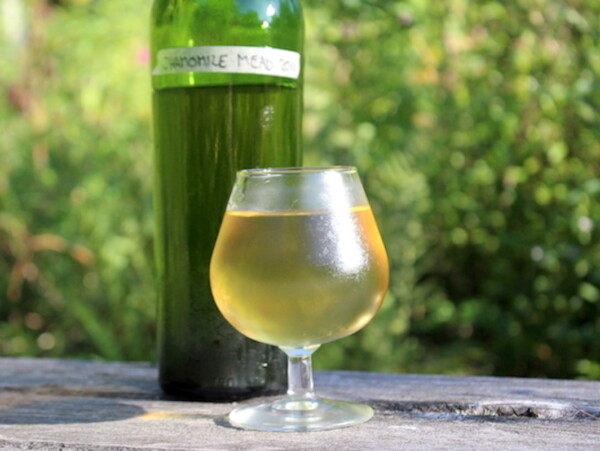Affiliate disclosure: This post may contain affiliate links. Please see our Privacy Policy.
Apricot wine seems to capture the essence of summer perfectly in a bottle. Adjust the sugar content to suit your tastes, or substitute honey for an apricot mead.

Apricot wine has a bright semi-sweet flavor that pairs well with summer nights and light lunches. For a drier wine, you can use less sugar, for a sweeter one, slightly more.
Apricots are a fruit that must ripen on the tree. Once picked, they soften but do not develop more flavor. Wait to pick your apricots at the peak of ripeness to imbue your wine with the most flavor.
The picking season for apricots varies by state. In some locations, like California, apricots ripen as soon as May. In other areas the season peaks in late July and August. See when the season is in your state to source the ripest, most flavorful fruit.
The basic process for making apricot wine follows the same steps as any small-batch country wine.
You’ll process the fruit and extract the juice, add some sugar or honey, and some other winemaking additives to balance the wine out. Finally, you’ll need a winemaking yeast to get it all going.
This little mixture will ferment for a week or two, where the most active fermentation stage will occur. Next, you’ll move the wine to a clean fermentation vessel, leaving the sediment behind, and let the wine ferment more slowly in secondary (hopefully somewhere cool and dark).
The length your wine can spend in secondary ranges from 6 weeks to 6 months. Once ready, you can bottle your wine, allow it to age for a month (or a few) and wait for those flavors to fully develop.
And best of all, this can all be done in your own home!

This recipe has been put together assuming that the reader is familiar with basic winemaking terms and practices. If you are less experienced or new to the winemaking process, I recommend you read a few guides before proceeding. Think of it as a little orientation!
- Beginners Guide to Making Fruit Wines will take you through all the steps in the winemaking process.
- How to Make Mead (Honey Wine) is pretty much the same, but is a must-read if working with honey.
- Equipment for Winemaking will inform you all about the durable equipment you’ll need to make your first batch (other than your ingredients).
- Ingredients for Winemaking will tell you what each of your ingredients does (besides yeast), why they are needed and possible substitutes for them.
- Yeast for Winemaking is, well, all about yeast! There are dozens upon dozens of yeast strains out there and you want to make sure you pick the right one. Here, I break down the differences exploring which yeasts are best for which wines.
Ingredients for Apricot Wine
To make apricot wine, you only need a few ingredients, many of which can be found in your own cupboard.
I’ve written this recipe so you can use either winemaking additives or pantry substitutes. If you’d like to read more about why each of these elements is needed, you can read this primer on winemaking ingredients to learn more.
For a one-gallon batch of apricot wine, you will need:
- 2 to 3 lbs apricots, chopped
- 2 to 3 lbs sugar
- 1 tsp Yeast Nutrient (or ⅛ cup raisins)
- 2 tsp Acid Blend (or 2 Tbsp lemon juice)
- ⅛ tsp Wine Tannin (or ½ cup strongly brewed black tea)
- Premier Blanc Wine Yeast
First, let’s start with the fruit. You’ll want about 2 to 3 pounds of nice ripe apricots all chopped up as well as 2 to 3 lbs of granulated sugar. If you’d like a drier wine, you can use an amount closer to 2 lbs, for a sweeter one, up that amount to 2-½ or 3 lbs.
You’ll also want 2 tsp acid blend or 2 tbsp lemon juice to add some acidity to your wine. Some wine tannin is also necessary to give the wine a balanced flavor. You can substitute a ½ cup of very strongly brewed black tea here if you prefer.
Lastly, you’ll need a nice wine yeast and a yeast nutrient to feed the yeast with plenty of micronutrients. You can substitute raisins in place of a teaspoon of yeast nutrient, but there is no substitute for a high quality wine yeast.
Although you can use any wine yeast that ferments clean or adds light fruit flavors, Premier Blanc wine yeast is preferred for apricot wine. This yeast has a relatively high alcohol tolerance (up to 15%) and is a strong fermenter. If this is unavailable, Lalvin 71B or Cotes des Blanc are also good choices.
For apricot mead, substitute 1 quart of honey for sugar. You can also add a spice like sliced ginger root to give some additional flavor to your mead.

Equipment for Winemaking
That’s it for ingredients. Next, let’s make sure you have all the appropriate equipment in working order. This includes:
- One Gallon Glass Carboy (often sold as a kit with a rubber stopper and water lock together)
- Rubber Stopper and Water Lock (if not included above)
- Brewing Siphon
- Wine Bottles or Flip-top Grolsch bottles
- Bottle Corker and clean, new corks for bottling the wine
- Brewing Sanitizer
Making Apricot Wine
To make apricot wine, start by extracting the juice from the fruit.
This will be done by pitting and chopping your apricots, moving them to a large bowl and covering them with sugar. The sugar will help to extract all those fruit juices from the fruit flesh. Stir the apricots to help the sugar cover them and let them sit for for 12 to 24 hours.
Next, you’ll want to strain the apricot pulp from the juice.
You can include it in the primary ferment if you use a wide-mouth fermenter as I’ve shown in the pictures, but it can cause quite a mess bubbling up into your water lock if you use a standard fermenter. I’ve made it both ways, and I prefer using a wide mouth fermenter to include the fruit since it extracts a bit more flavor that way.
Strain the flesh from your mixture using a fine mesh strainer and pour the apricot juice into your primary fermentation vessel. Pour some water into the bowl that you let the fruit sit in as well to collect the last of the juice and sugar. Strain this and pour it into your carboy.
Add your acid blend, wine tannin, and yeast nutrient next, and fill the carboy ¾ full with water.
The yeast should be added last. Rehydrate the wine yeast in a small amount of room-temperature water before adding it to your carboy. Once added, stir to incorporate all the ingredients. Finish by filling the carboy with water to bring the mixture to just below the neck of the carboy, seal it with a water lock and let the fermentation begin.
Lots of active bubbling should be seen at this point. This is the most active part of the fermentation process.
Let the wine ferment here in primary for 10 to 14 days. The active fermentation should have begun to slow at this point. Now it’s time to siphon the wine over to a clean fermentation vessel for secondary, leaving the sediment behind.
After racking the wine to a clean carboy, top it up with more water to bring the wine up to the neck of the carboy (you want to minimize the surface area that is exposed to air) and seal with a water lock.
Allow the wine to ferment here in secondary for at least another 6 weeks, but preferably longer. Apricot wine can take anywhere from 3 to 6 months to clarify.
Once ready, sample the wine, adjust it to taste if needed and then bottle it in clean, sterilized wine bottles and seal with corks.
If you sample the wine and find it too dry for your tastes, you can backsweeten. To do so, rack the wine to a clean container and stabilize it (done by adding 1 Campden tablet and ½ teaspoon potassium sorbate). Wait 24 to 48 hours, then add sugar in the form of a simple syrup. Reseal the water lock and leave for 1 week before bottling to ensure that the ferment does not restart.
Let the wine bottle age for at least a month before drinking. Wine always improves with age and apricot wine is no different!
Ways to Preserve Apricot
Looking for more ways to preserve apricots?

Apricot Wine
Equipment
- Air Lock & Stopper
Ingredients
- 2 to 3 lbs apricots, chopped
- 2 to 3 pounds Sugar, about 2 cups per pound
- 1 tsp yeast nutrient
- 2 tsp acid blend
- ⅛ tsp tannin powder
- 1 packet wine yeast, see note
- Optional ~ Campden Tablet and Potassium Sorbate for Stabilizing, I do not use these
Instructions
- Begin by removing the pits from the apricots and chopping them up into smaller sections.
- Move apricots to a large bowl and cover them with sugar. Stir them regularly to ensure the sugar covers all sections and helps to extract the juice. Wait 12 to 24 hours for the juice to extract.
- Once the juice has been extracted, strain the apricot juice into your primary fermentation vessel. (Or use a wide-mouth fermenter and include the pulp in primary to extract a bit more flavor. The fruit will need to be strained before secondary. Placing the fruit in a brewing bag can help keep things clean. Do not include the fruit pulp if using a standard narrow-neck fermenter, as it will clog the water lock and make a mess.)
- Add some water to the bowl that the apricots were left to juice in. Strain this and pour it into your primary fermentation vessel to make sure the last of the sugar and apricot juice make it in as well.
- Add your wine tannin, acid blend, and yeast nutrient. Add enough water to bring the level to ¾ full.
- Add the wine yeast last. Rehydrate in a small amount of room temperature water (about ¼ cup) for 10 minutes and add to the carboy. Stir ingredients to incorporate.
- Top with enough water to bring the level up to just below the neck of the carboy and seal with a water lock.
- Allow to ferment in primary for 10 to 14 days.
- Siphon the mixture to a clean carboy, leaving sediment behind. (And also leaving any fruit pulp behind if you included the fruit in primary.)
- Top it up with water, seal it with a water lock, and let it ferment in secondary for at least 6 weeks. For the best wine, ferment in secondary for 3 to 6 months.
- At the end of secondary, sample the wine. Adjust to taste (see notes for info on backsweetening).
- Rack the wine into wine bottles and seal with wine corks. Let wine bottle-age at least 1 month before drinking (and preferably for a year for the best result).
Notes
Apricot Mead
To make apricot mead, substitute 1 quart (3 lbs) of honey for the sugar. You’ll need to crush the fruit to extract the juice and strain it through a fine mesh strainer before adding it to the carboy. Note, the time spent in secondary may be longer than for wine, as the honey is harder for yeast to digest than sugar.Yeast
For apricot wine, choose a wine yeast with moderate alcohol tolerance, that ferments clean or adds light fruit flavors. Premier Blanc wine yeast is preferred but Lalvin 71B or Cotes des Blanc are also good choices. Stabilizing and Back Sweetening ~ If you sample your wine at the end of secondary and find it too dry, you can always backsweeten to counteract this. To backsweeten, rack the wine to a clean container and stabilize it by adding 1 Campden tablet and ½ teaspoon potassium sorbate to kill the yeast and stop the ferment. Adding sugar may restart fermentation and cause bottled wine to burst if not stabilized first. Wait 24 to 48 hours after stabilizing before adding sugar. Add sugar in the form of a simple syrup made by heating equal parts sugar and water. For a one-gallon batch of apricot wine, I suggest starting with ½ cup sugar when backsweetening. After adding sugar, reseal the water lock and put it back into ferment for a week before bottling. See notes within the article for more information regarding stabilizing and back sweetening.Nutrition
Nutrition information is automatically calculated, so should only be used as an approximation.
Winemaking Recipes
In search of more winemaking recipes? I have one for almost every fruit there is (and some veggie and flower wines, too).




